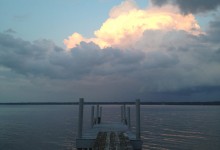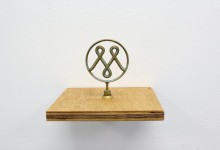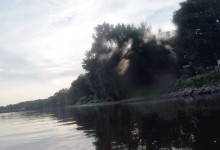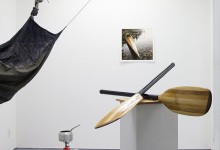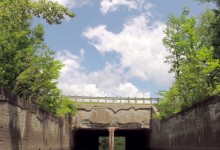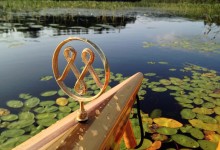Opening reception: Saturday, January 16th from 3-5pm
Patrick Beaulieu: Méandre
Text by Isabelle Lynch
In 2014, Patrick Beaulieu, whose “performative trajectories” have led him to follow the American winds (Ventury, 2010) and the migration of monarch butterflies (Monarch Vector, 2007), embarked on a poetic meandering voyage in his handmade cedar kayak. Beaulieu surrendered to the ebbs and flows of the world by drifting from the source of the Missisquoi river in Quebec to the mouth of the Hudson River in New York.
While submarines and cargo ships map out their trajectories with electronic navigation devices and complex passage planning, Beaulieu’s Meander embraced slowness and loss of control and followed the fluid current that runs between seemingly stable land masses. The artist chose to follow the Missisquoi river due to the water current’s slowness and the fact that the body of water has a history of being used as a navigation tool by First Nations peoples. Beaulieu spent 30 days drifting on the sky-dyed waters, stopping to hang his hammock for the night. Following the water’s current, the artist found contentment in the slowness and the state of abandon with which he navigated as the journey allowed for a meditative experience and an exercise of attention.
Floating on the water and renouncing volition, certainty and action, Beaulieu’s trip threatened to slowly erode the seemingly stable ideas we have of freedom, self, and space. Surrendering to the forces of nature, Beaulieu’s Meander embraced a particular kind of passivity and non-action that gives rise to new definitions and experiences of freedom. Indeed, the artist’s absurd voyage echoes Albert Camus’s idea that freedom can only exist in the recognition of the absurdity of existence, in recognizing that the current will take you where it wants to. By accepting the possibility of tipping over and loosing balance, and by choosing to follow the water, Beaulieu’s Meander exercises a freedom that is in tune with the subtle currents of the world and powers greater than us.
Beaulieu’s journey may remind us of Bas Jan Ader’s 1975 transatlantic sailing voyage In Search of the Miraculous, during which the artist mysteriously vanished to a space both unmapped and irrational. Like Ader, who departed from Cape Cod with a camera and tape recorder, Beaulieu set out to record his trip with a GoPro camera. Pushed by the force of the water under his canoe, Beaulieu recorded the pace of being adrift. Relinquishing his artistic authority to the waves, Beaulieu set up a fixed camera that filmed short videos of his voyage, the sway of the canoe working to compose the images.
In his exhibition at Art Mûr, Beaulieu shares his experiences through photographs, a series of short videos titled Points of Confluence, and animated sculptures that act as vestiges of his time on the water. A perpetually rocking cedar kayak, a spastic hammock, a cauldron containing a whirlpool, two whispering cedar paddles, a flashlight revealing lunar cycles, and a burnt bowl of oatmeal are among the objects exhibited.
Floating, drifting, and meandering from Quebec to New York, the artist travelled aimlessly, letting the current take him. Nonetheless, Patrick Beaulieu’s voyage was not an aimless one: as the water’s natural forces eroded the ordering concepts of departure and arrival, beginning and end, the artist’s destination was much greater than any point on a map.



